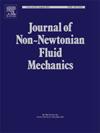幂律流体在轴向变化几何形状填充毛细血管中的自发渗吸
IF 2.8
2区 工程技术
Q2 MECHANICS
引用次数: 0
摘要
湿润流体在密闭孔隙空间中的吸胀是自然界普遍存在的现象。为了理解牛顿流体在毛细血管中的侵入,已经做了几次尝试。然而,由于吸胀过程中存在动态剪切速率,非牛顿流体的吸胀研究相对较少。在这项工作中,我们建立了控制一种幂律流体与另一种幂律流体在轴向发散和收敛毛细血管中的位移的方程。利用润滑近似,建立了一维控制方程,对剪切减薄、剪切增厚和牛顿流体的各种组合进行了随时间的推进界面建模。针对这一吸胀现象,我们探讨了吸留流体幂律指数、它们的时间尺度、界面性质以及几何参数的影响。所建立的方程是一个综合的数学模型,在考虑特殊情况的情况下,可以从所建立的模型中检索到文献中已有的自吸关系。我们还确定了早期和晚期的流动状态,其中吸入流体或驻留流体的粘性阻力占主导地位。该研究将有助于设计具有理想流动特性的孔隙空间几何参数,在微流体领域具有广泛的应用前景。本文章由计算机程序翻译,如有差异,请以英文原文为准。
Spontaneous imbibition of power-law fluids in filled capillaries of axially varying geometries
Imbibition of wetting fluids in confined pore spaces is a ubiquitous phenomenon in nature. Several attempts have been made to understand the invasion of Newtonian fluids in capillaries. The imbibition of non-Newtonian fluids, however, is relatively less explored owing to the dynamic shear rate during the imbibition process. In this work, we develop equations governing the displacement of one power-law fluid with another power-law fluid in axially diverging and converging capillaries. Using lubrication approximation, the governing equations in one-dimension are developed to model the advancing interface with time for various combinations of shear-thinning, shear-thickening, and Newtonian fluids. For this imbibition phenomenon, we explore the effect of imbibing and residing fluid power-law indices, their time scales, interfacial properties, and the impact of the geometric parameters. The developed equations serve as a comprehensive mathematical model, and the self-imbibition relations available in literature can be retrieved from the developed model by considering special cases. We also identify early and late regimes of flow where the viscous resistance of either the imbibing or the residing fluid dominates the imbibition. This study will help design geometrical parameters for pore space with desired flow properties, and has wide applications in microfluidics.
求助全文
通过发布文献求助,成功后即可免费获取论文全文。
去求助
来源期刊
CiteScore
5.00
自引率
19.40%
发文量
109
审稿时长
61 days
期刊介绍:
The Journal of Non-Newtonian Fluid Mechanics publishes research on flowing soft matter systems. Submissions in all areas of flowing complex fluids are welcomed, including polymer melts and solutions, suspensions, colloids, surfactant solutions, biological fluids, gels, liquid crystals and granular materials. Flow problems relevant to microfluidics, lab-on-a-chip, nanofluidics, biological flows, geophysical flows, industrial processes and other applications are of interest.
Subjects considered suitable for the journal include the following (not necessarily in order of importance):
Theoretical, computational and experimental studies of naturally or technologically relevant flow problems where the non-Newtonian nature of the fluid is important in determining the character of the flow. We seek in particular studies that lend mechanistic insight into flow behavior in complex fluids or highlight flow phenomena unique to complex fluids. Examples include
Instabilities, unsteady and turbulent or chaotic flow characteristics in non-Newtonian fluids,
Multiphase flows involving complex fluids,
Problems involving transport phenomena such as heat and mass transfer and mixing, to the extent that the non-Newtonian flow behavior is central to the transport phenomena,
Novel flow situations that suggest the need for further theoretical study,
Practical situations of flow that are in need of systematic theoretical and experimental research. Such issues and developments commonly arise, for example, in the polymer processing, petroleum, pharmaceutical, biomedical and consumer product industries.

 求助内容:
求助内容: 应助结果提醒方式:
应助结果提醒方式:


